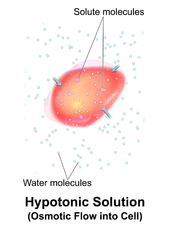
Back انحلال الدم Arabic Hemoliz Azerbaijani هئمولیز AZB Гемоліз Byelorussian Хемолиза Bulgarian লালিকানাশ Bengali/Bangla Hemoliza BS Hemòlisi Catalan Hemolýza Czech Hämolyse German
This article needs more reliable medical references for verification or relies too heavily on primary sources. (November 2021) |  |
| Hemolysis | |
|---|---|
| Other names | Haemolysis (alternative spelling), hematolysis, erythrolysis, or erythrocytolysis |
 | |
| Specialty | Pathology |
| Complications | Kidney failure, kidney disease |
| Causes | Osmosis |


Hemolysis or haemolysis (⫽hiːˈmɒlɪsɪs⫽),[1] also known by several other names, is the rupturing (lysis) of red blood cells (erythrocytes) and the release of their contents (cytoplasm) into surrounding fluid (e.g. blood plasma). Hemolysis may occur in vivo or in vitro.
One cause of hemolysis is the action of hemolysins, toxins that are produced by certain pathogenic bacteria or fungi. Another cause is intense physical exercise.[2] Hemolysins damage the red blood cell's cytoplasmic membrane, causing lysis and eventually cell death.[3]
- ^ Wells, John C. (2008). Longman Pronunciation Dictionary (3rd ed.). Longman. ISBN 978-1-4058-8118-0.
- ^ Witek, K; Ścisłowska, J; Turowski, D; Lerczak, K; Lewandowska-Pachecka, S; Pokrywka, A (March 2017). "Total bilirubin in athletes, determination of reference range". Biology of Sport. 34 (1): 45–48. doi:10.5114/biolsport.2017.63732. ISSN 0860-021X. PMC 5377560. PMID 28416897.
- ^ Madigan, Michael T. (2010). Brock Biology of Microorganisms 13th Edition. Benjamin Cummings. p. 804. ISBN 978-0-321-64963-8.